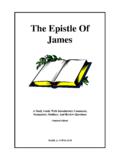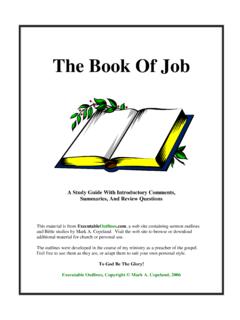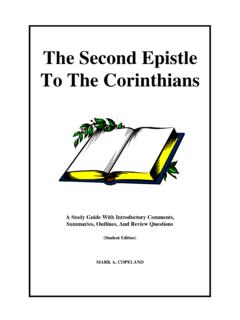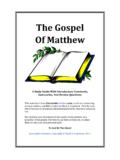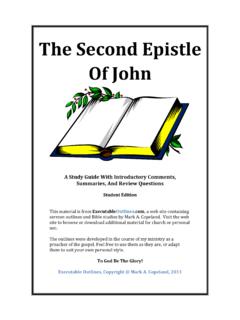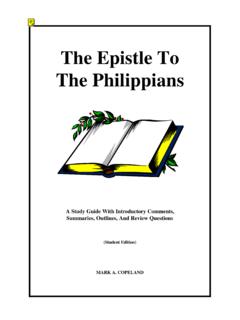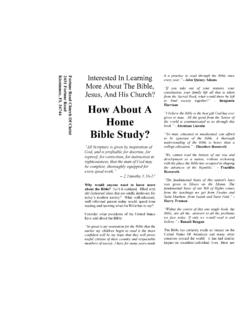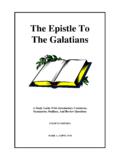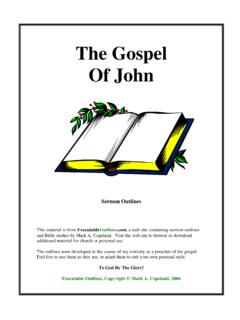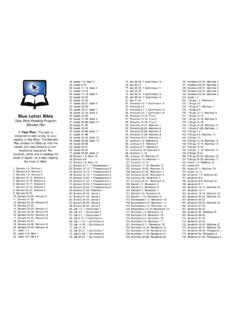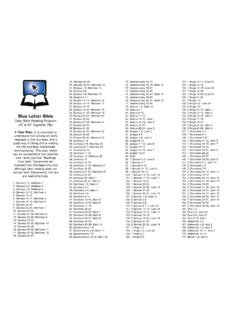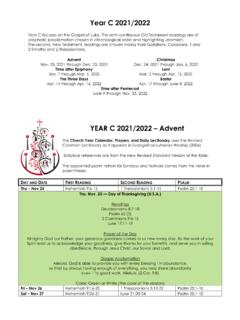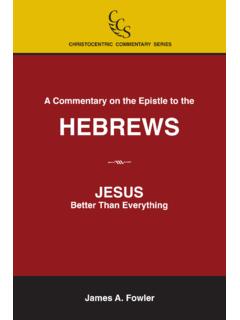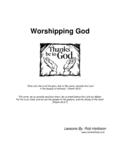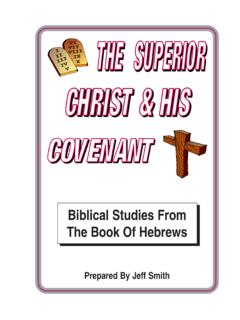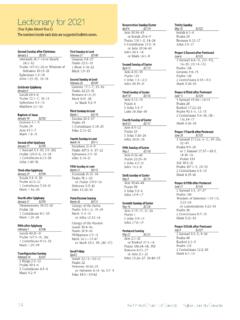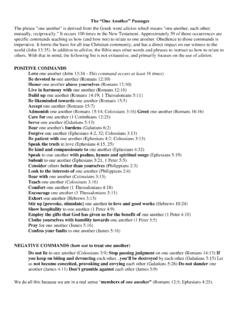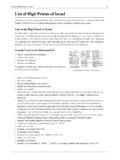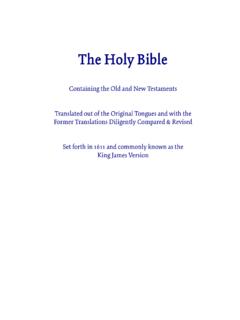Transcription of The Epistle To The Hebrews - Executable Outlines
1 The Epistle To The Hebrews Sermon Outlines This material is from , a web site containing sermon Outlines and Bible studies by Mark A. Copeland. Visit the web site to browse or download additional material for church or personal use. The Outlines were developed in the course of my ministry as a preacher of the gospel. Feel free to use them as they are, or adapt them to suit your own personal style. To God Be The Glory! Executable Outlines , Copyright Mark A. Copeland, 2006. Mark A. Copeland The Epistle To The Hebrews Table Of Contents Introduction To The Epistle 3. God's Perfect Spokesman (1:1-3) 6. Jesus' Superiority To Angels (1:4-14) 9. Lest We Drift Away (2:1-4) 13. Advantages Of Jesus' Humanity (2:5-18) 17.
2 The Supremacy Of Jesus Over Moses (3:1-6) 20. A Warning From The Wilderness (3:7-19) 23. The Rest That Remains (4:1-11) 27. God's Powerful Word (4:12-13) 31. Coming Boldly To The Throne Of Grace (4:14-16) 34. Christ's Qualifications As High Priest (5:1-10) 37. Marks Of Spiritual Immaturity (5:11-14) 40. The Peril Of Not Progressing (6:1-8) 44. The Basis For Spiritual Security (6:9-20) 48. The Greatness Of Melchizedek (7:1-10) 51. The Significance Of Christ's Priesthood (7:11-19) 54. The Superiority Of Christ's Priesthood (7:20-28) 57. Our Glorious High Priest (8:1-6) 60. The Promises Of God's New Covenant (8:7-13) 63. The Earthly Sanctuary (9:1-10) 66. The Superior Sanctuary (9:11-28) 70.
3 The Superior Sacrifice (10:1-18) 74. A Gracious Exhortation (10:19-25) 77. A Warning Against Willful Sin (10:26-39) 80. Faith That Pleases God (11:1-7) 84. Faith That Embraces The Promises (11:8-22) 88. Faith That Overcomes The World (11:23-40) 91. Running The Race Of Faith (12:1-3) 95. The Chastening Of The Lord (12:4-11) 98. The Pursuit Of Peace And Holiness (12:12-17) 102. Heeding The Voice From The Mountain (12:18-29) 106. Exhortations To Manifest Love (13:1-3) 110. Fornicators And Adulterers God Will Judge (13:4) 113. A Call To Be Content (13:5-6) 117. Stability In Our Service To God (13:7-17) 121. Closing Words Befitting A Grand Epistle (13:18-25) 124. Sermons From Hebrews 2. Mark A.
4 Copeland The Epistle To The Hebrews Introduction To The Epistle INTRODUCTION. 1. The Epistle to the Hebrews is a unique book in the New a. It begins as an essay - He 1:1-2. b. It progresses as a sermon - He 2:1-4. c. It ends as a letter - He 13:23-25. 2. Its contents are deep and a. Many Christians find it difficult b. Some equate its difficulty with the book of Revelation 3. But for Christians who are willing to take the time to read and reflect upon a. They are reminded of how blessed they are to have trusted in Christ b. They are impressed with the superiority of Christ and His New Covenant over Moses and the Old Covenant c. They are warned of the danger of apostasy and the need for steadfastness in their faith 4.
5 With this lesson, I wish to begin a series of expository sermons based upon this a. Yet just as one should not begin a journey without some idea of where they are going b. So it is beneficial to begin with a preview of this Epistle , that we might have an 1) Of where we are headed 2) And what we can expect to find [Such a preview or introduction would naturally include some information ]. I. THE BACKGROUND TO THIS Epistle . A. THE 1. The author does not identify himself 2. Many believe it to be the apostle Paul ( , Clement of Alexandria). a. This seems unlikely in view of the author's statement: ..was confirmed to us by those who heard Him, - He 2:3. b. For Paul declared that he had not received the gospel from or through men - Ga 1: 11-12.
6 C. Yet there are many arguments which favor Paul as the author (cf. New Testament Commentary on Hebrews , Robert Milligan, pp. 5-19). 3. Other names have been proposed over the years: a. Barnabas (suggested by Tertullian). b. Apollos (suggested by Luther). c. Priscilla (suggested by Harnack). -- Perhaps Origen says it best, But who wrote the Epistle , to be sure, only God knows.. B. THE 1. The general consensus is that this letter was written to Jewish Christians Sermons From Hebrews 3. Mark A. Copeland 2. But there is uncertainty as to where they and the author were at the time of composition a. Most believe the recipients were in Palestine, and the author in Rome b. Others suggest the readers were in Rome and the author elsewhere, based upon a possible implication in He 13:24.
7 -- In any case, they were Jewish Christians whom the author knew personally - cf. He 10: 34; 13:19. C. THE DATE OF 1. We know it was prior to 96 , for Clement of Rome quotes from Hebrews in his letter written at that time 2. There are certainly strong implications that it was written prior to 70 a. There is no mention of the destruction of Jerusalem and the temple b. The author writes as though priests were still offering sacrifices - He 8:4; 10:11. 3. If the Jewish Christians were in Palestine, it was likely before or at the beginning of the Jewish Wars (ca. 66-70 ), in light of He 12:4. -- The time frame of 63-65 is often suggested D. THE PURPOSE OF THIS 1. To prevent his readers from abandoning their faith in Christ - cf.
8 He 2:1-4. 2. To encourage his Jewish brethren not to go back to the Old Law a. By showing the superiority of Christ and His Covenant - cf. He 8:1-2,6. b. A key word found throughout the Epistle is better . 1) Christ is better than the angels - He 1:4. 2) We enjoy the bringing in of a better hope - He 7:19. 3) Jesus has become the surety of a better covenant - He 7:22. 4) He is also the Mediator of a better covenant, which was established on better promises - He 8:6. 5) The heavenly things benefit from better sacrifices - He 9:23. -- Indeed, the purpose of this Epistle has been to exhort his readers - He 13:22. [With this background to the Epistle , let's continue our brief survey of the book by ].
9 II. THE MAIN DIVISIONS OF THIS Epistle . A. THE SUPERIORITY OF - He 1:1-8:6. 1. Better than the prophets, as a much better Spokesman - He 1:1-3. 2. Better than the angels, by virtue of His Deity and humanity - He 1:4-2:18. 3. Better than Moses, for He is the Son who provides a heavenly rest - He 3:1-4:13. 4. Better than Aaron, as His priesthood is a superior one - He 4:16-8:6. B. THE SUPERIORITY OF THE NEW - He 8:7-10:18. 1. For it is based upon better promises - He 8:7-13. 2. For it is based upon a better sanctuary - He 9:1-28. 3. For it is based upon a better sacrifice - He 10:1-18. C. EXHORTATIONS DRAWN FROM THIS - He 10:19-13:25. 1. To draw near to God and hold fast - He 10:19-39. 2.
10 To run the race of faith with endurance - He 11:1-12:29. 3. Miscellaneous exhortations - He 13:1-25. Sermons From Hebrews 4. Mark A. Copeland [A unique feature of The Epistle To The Hebrews are the warnings throughout the book. As we conclude this introduction, perhaps it may be profitable to ]. III. THE KEY WARNINGS IN THIS Epistle . A. THE WARNING AGAINST - He 2:1-4. 1. Through neglect we can easily drift away 2. The solution is to give the more earnest heed to the things we have heard B. THE WARNING AGAINST - He 3:12-15. 1. Through sin's deceitfulness we can become hardened and develop a lack of faith by which we can depart from the living God 2. The solution is exhort one another daily and remain steadfast C.
